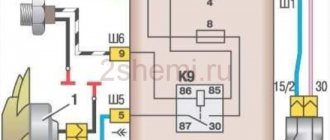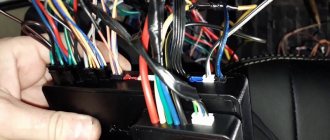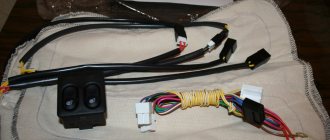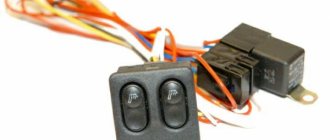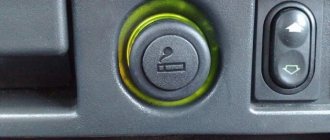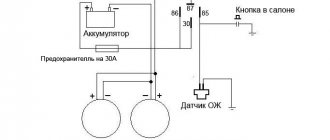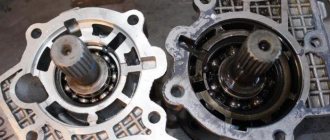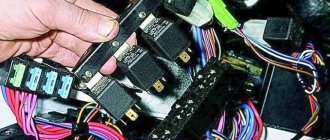Dear customers, in order to avoid errors when sending a seat heating harness 2123 with a Euro connector, in the “Comment” line indicate which connector is Euro or simple, your car model, year of manufacture, which key or block of electric heating control buttons is used.
For every driver, comfort when operating a car plays an important role. The climate in Russia is quite harsh; sitting in a car for a long time, especially in the cold, is not a pleasant experience. Everyone knows how quickly the interior of a car cools in the winter in an open parking lot or in an unheated garage. Usually a car has a heating system for the interior, but this is not always enough. That's why car seat heaters are simply indispensable accessories in cold weather.
Wiring harness 2123-3724076 with Euro connector, connects to heated front seats with Euro connector in 4 x 4 cars, Chevrolet Niva and their modifications. Can be used for self-installation and replacement. The contacts are already crimped onto the wires and inserted into the connectors according to the pinout, so they can be installed on the car.
Wiring harness for heated front seats 21230-3724076-00:
31 - to the electric heating control unit;
32 — to the electric heater of the right seat;
33 — to the rear harness block;
34 - to the electric heater of the left seat.
Stationary heating elements are mounted between the upholstery and the foam layer of the car seat. For their manufacture, mats made of carbon fiber fabric or reinforced wires are used.
Carbon fiber or thermal fiber mats do not have any restrictions. They can be cut at the desired location to attach the fittings to the car seat. The cost of such products is high, but is compensated by reliability.
Heating the seats in the car not only increases driving comfort, but also protects against many diseases associated with constant hypothermia.
In new cars, this function is most often provided initially, but owners of domestic cars are often forced to solve the problem on their own.
Installation and replacement of the harness 2123-3724076 with a Euro connector, which is connected to the heated front seats with a Euro connector in 4 x 4 cars, Chevrolet Niva and their modifications, can be done independently, without contacting specialized service centers.
Other article numbers of the product and its analogues in catalogues: 21230372407600.
VAZ 2123, VAZ 21213-21214i heated seats with Euro connector.
Any breakdown is not the end of the world, but a completely solvable problem!
Seat heating does not work: reasons
It is not difficult to guess that the seats are heated by a special heater when power is supplied to it.
On the Niva Chevrolet there are two elements, on each of two seats, connected by a separate line, but working synchronously when turned on.
And when the button is turned on, the current passing through the relay turns on the heaters. For the best visualization of the device operation, a special indicator is provided on the button. If it does not light up, this will indicate an open circuit and inoperability of the circuit for a short circuit.
This is what the switch looks like when installed.
Checking circuit elements
If heating does not work, you need to check the following:
- Fuse with a rating of 15-20 Amperes , or a relay.
- Broken wiring or heating elements.
- Heating button . Such a malfunction is extremely rare.
The best place to start is by checking the relays and fuses. They are located in the mounting block, or rather in its lower part. They must be checked by visual inspection, or by replacement with a known-good spare part.
Connection diagram and mounting block
The required fuse is located under F15, and the relay is located under the designation “K”.
Next, you should measure the resistance, voltage and current along the wires; if it is present, then you can move on to the heating elements.
Heated seat covers for Chevrolet Niva
- ease of installation
- change the design of your salon and ease of connection
flaws
- The cigarette lighter only works when ignited, which means you can’t leave this system on overnight
- the quality of the cases requires the best
- achieving fixation is almost impossible
Advantages of a built-in heating system:
- more stable and reliable operation, since the heating element is made of carbon fiber
- ease of use, such systems are equipped with an on/off button. After reaching the desired temperature, the system automatically turns off
- the system is equipped with a fuse and in case of a possible short circuit it will blow out
The service life of heating systems is very long, often they last much longer than the car. As for the appearance, nothing will change after installation; the built-in heating system is installed under the seat trim, so the appearance remains the same. You can install a heating system on almost any car. You may ask why practically, because there are cars on which the seats are glued to foam rubber; if you peel off the trim, the seat will lose its aesthetic appearance. But in reality such cases are rare.
A SET OF SOME DIAGRAMS FOR NIVA CHEVROLET
Wiring diagram for fog lights
I - Fog lights, II - fuse box, III - fog light switch, IV - fog light relay. A - Constant voltage, B - to side lights
Seat heating connection diagram
I - Heating elements, II - seat heating switch, III - heating relay, IV - ignition switch A - Side lights, B - to the battery.
Wiring diagram for heating and controlling mirrors
1 - Ignition switch, 2 - fuse block, 3 - heated mirror relay, 4 - mirrors, 5 - mirror control switch, 6 - heated mirror switch. A - To the battery, B - to the side lights.
Connection diagram for tape recorder and speakers
1 - Radio, 2 - front right speaker, 3 - rear right speaker, 4 - rear left speaker, 5 - front left speaker. A - To the side lights, B - to the battery.
Radiator cooling fan switching diagram
1, 7 — Radiator cooling fan, 2, 6 — low speed relay, 3 — fuse, 4 — engine control unit, 8 — high speed relay. A, C - To the battery, B - to the power sensor.
Equipment:
- Heating element - 4 pcs.
- Button block - 1 pc.
- Mounting kit for connection - 1 pc.
- Installation diagram - 1 pc.
The product is certified
Set: 4 heating elements, button block, installation kit, diagram
Grant's electrical circuit responsible for the engine compartment
Here are the main parts of the Lada Granta wiring, which are responsible for the normal operation of the power plant:
- 1 – power supply to the headlight, front right;
- 2 – power supply for windshield washers;
- 3 – voltage to the left side of the head optics;
- 5 – on-board power supply;
- 6 – head fuse block;
- 7 – generator;
- 8 – horn;
- 9-11 – terminal blocks to the dashboard;
- 12 – contact pair of rear headlights;
- 13 – main radiator fan drive.
How to change fuses?
To change the fuse links in the Niva Chevrolet fuse box, you need to understand the electrical circuit of the car. A failed fuse can be identified visually or using a tester. To do this, turn on the device in the closed circuit sound test mode and install the probe tips on the fuse contacts.
Test procedure and tweezers
The replacement itself, for example, a windshield wiper fuse with a rating of 20 A (position F9 on both blocks), is carried out as follows:
- Open the block cover.
- Find the failed insert.
- Take it with tweezers and pull it out of the nest.
- A fuse of the same rating must be installed instead. The use of inserts of a higher rating can lead to burnout of the unit and electrical wiring, as well as to a vehicle fire. Using parts with a lower rating will also not protect the circuit, since such an insert will immediately burn out.
- Turn on the circuit in which the insert was replaced. If re-burnout occurs, then the problem is in the elements of this circuit.
- Place the tweezers in their original place and close the lid.
The process of replacing one of the fuses is shown in the video from the Remgar channel.
Seat heating kit for VAZ 2121
APPLICABILITY: VAZ 2121 Can be installed on VAZ 2121,2108 (it is necessary to ensure that the seat can be reclined unhindered by wires).
Built-in heating kit for the two front seats.
Today you rarely find a modern car that does not have a heated seat function from the factory. But, unfortunately, not every LADA configuration has such an option. Heated seats in a car are a very convenient and essential attribute in the autumn and winter. Many car owners who do not have automatic engine start or heated seats in their car are familiar with the unpleasant feeling of sitting on a cold seat in frosty weather.
This seat heating kit is designed for installation on cars of the Lada Samara family. The product is created according to the formula: the length of the heating filament - the resistance of the material - the voltage of the on-board network. This means that a heating filament of this length, at a voltage of 12.0-13.5 V, cannot heat up more than 53 ° C. The fabric heating base is made of non-flammable material. A nichrome thread with fluoroplastic insulation is used as a heating element. Thus, the possibility of the product catching fire is completely eliminated.
SPECIFICATIONS:
— normal supply voltage 12 V; — current consumption 3-5 A; — rated power 40 W; — heating time of the module surface to operating temperature is 5-10 minutes; — heater surface temperature +53 °C; — overall dimensions of each module are 290x370 mm.
Set contents:
— module with heating element — 4 pcs.; — installation kit of mounting wires; — heating control key — 2 pcs.
Installation on a car.
Heaters can be installed in special pockets on the inside of car seats or under seat upholstery. The inadmissibility of creasing or displacement of heater elements during their operation must be ensured by their additional fastening. When installed in car seat covers, the heaters are inserted into additional pockets on the back and seat of the covers from the inside. Heaters can be attached to covers in the following ways: using double-sided tape; using fabric glue (the glue should be odorless!); If the materials of the covers are thin, the heaters can be hemmed to the covers; for this purpose, fastening zones are provided at the edges of each heater. When installed under the seat upholstery, the heaters are glued to the foam lining of the chair with double-sided tape: one heater to the seat, the second to the back. The heating control keys have two positions (ON/OFF) and are installed in standard places on the instrument panel.
Lada Granta diagram - ignition part
- 1 – indicator of lubricant pressure in the crankcase of the power plant;
- 2 – generator connector;
- 3 – power supply to the fuel mixture supply valve;
- 4 – cooling system thermometer;
- 5 – sending a signal to the dashboard;
- 6 – adsorber purge;
- 7 – speedometer;
- 8 – mass air flow sensor;
- 9 – DPKV;
- 10 – DC in front of the catalyst;
- 11 – control pulse device;
- 12 – oxygen concentration sensor in exhaust gases;
- 13/14 – coil and spark plugs, respectively;
- 15 – injector drivers;
- 16 – ignition contact group;
- 17 – detonation measurement sensor.
Why the heated rear window and heated mirrors do not work on Niva Chevrolet
Heated rear window on Niva Chevrolet is electrically conductive parallel threads applied to the surface of the rear window, connected to vertical (on the sides) wires.
Restoring rear window heating threads on a Chevrolet Niva
There are a number of ways to restore heating yourself. The choice of any of them is tied to the size (width) of the gap and the characteristics of the thread.
The experience of their restoration is based on proven methods.
- Use electrically conductive paste or adhesive, with a gap width of a millimeter. The repair package contains paste, syringe, and glass cleaning items. The use of electrically conductive glue “Elekont” or “Kontaktol”, which is applied to the area where the thread is broken.
Troubleshooting
After checking the possible causes, the defect may lie in the switch or its button.
Search for an open circuit in the power supply circuit for heated rear mirrors.
The worst case scenario is that the problem lies in the wiring, which can be fixed by disassembling the dashboard.
The fuse for the heated rear window and mirrors is number 8 in the mounting block. Capacity 25 Ampere. The problem may be there. In the photo, due to poor contact, the seat presumably melted. There could be a fire.
Often the lack of signs of warming up is hidden in the fuse or heating control relay.
There are frequent cases of detection of defects related to the connection of the thread harness to the vehicle’s instrument system.
Checking the fuse box with a tester
The first fault is detected by the tester. The relay is checked by replacing it, albeit a used one, but with a working device.
An available option is to restore possible thread breaks. But often drivers resort to replacing the entire rear window, which is very expensive.
Chevrolet Niva seat heating connection diagram
Installed seats with built-in heating. As the installers said, the heating is standard, the one that is now installed in VAZ. I decided to connect myself, to try my hand, so to speak. It should be noted that this is generally my first experience in “connections” with automotive electricals, and if it weren’t for ALER’s help in developing the circuit and his answers to all my stupid questions, this article would not have existed.
So, it was bought:
— two backlit buttons with a power indicator from the 15th VAZ panel, two-position: released/pressed; Included with the buttons are their counterparts with wires:
— 2 four-pin or five-pin relays; — 2 separate fuses with 25 A blocks (installed only one); - 6 meters of power wire per 2 mm 2; - 5 meters of two-core wire for control 0.5 mm 2; — plug to the chairs for connection; — 20 pieces of terminals for the relay (in reserve); — 3 ring terminals: 2 pcs. for heater masses, 1 pc. to the battery; — 5 terminals for the button blocks — small ones (just in case); — 10 “hooligans” (for inserting into wires).
Note. “Hooligan” was what store salespeople called such a plastic block about 1 cm long and wide and 2 cm long with grooves inside into which two wires are inserted in parallel through a side slit. When they are inserted, a toothed metal plate is clamped on top with pliers (it cuts through the insulation, ensuring contact between these wires), and then the plastic cap is snapped on. The main thing here is that the wire lies exactly in the groove and is not particularly thin so that the plate can reach it. On one of my hooligans there was no contact to the ground - I just had to cut in next to it and insulate the twist with electrical tape.
The total budget was 495 rubles.
Remove the plastic trim from the driver's left leg (all the wires are hidden behind it). Remove the beard and plastic tunnel cover. Remove the tunnel cover and handbrake housing.
In order to remove the tunnel cover, at least the passenger seat must be removed. The driver's license will have to be removed to put everything back in place.
The installation was carried out according to the diagram kindly compiled by ALER:
Installation instructions
The buttons are located on the tunnel lining.
The power wire was led directly from the battery through the standard hole on the left in the engine compartment into the passenger compartment. I hid the relay behind my beard, the fuse is just hanging there nearby.
For the driver's seat, the length of the wire should be about 1.2 meters, for the passenger's seat +30 cm so that everything fits under the tunnel, and it is possible to easily adjust the travel of the seats.
I brought the mass to the heaters using two ring terminals on the handbrake mount. You need to leave about 40 cm.
The control, indication and button illumination were connected using a two-core wire. Clinging to the beard according to the pattern. The length must be such that when the beard is disconnected and the tunnel cover is removed, the button can freely reach the handbrake mount.
Well, here you will have to be patient and arm yourself with an awl to find holes for all the screws that have been turned out under standard or not very sound insulation. The process is tedious and inconvenient, requiring extreme concentration and time.
During assembly, it turned out that the height of the casing for the bottom button in the place where it is located is not enough for me, i.e. There is room for the button and the block, but the wires don’t immediately bend to the sides, and it turns out that they push it out and make it crooked. There are several options: raise it higher, place two buttons next to each other horizontally, or, as I had to do, connect the wires to the button directly without a block.
So, today I did what I had planned for a long time - I completely installed the heating regulators for the capes.
I decided not to do the shutdown when the ignition is turned off. It’s certainly more convenient, but whatever, I never forgot to turn off the heating. However, installing the relay will not take long; if there is a need, I will install it.
Actually, what prompted it - well, look for yourself - it’s not a very attractive picture, is it? (Sorry. For some reason the interior is dirtier in the photo than it really is.)
A big plus of the Zhara capes, in addition to their presentable appearance, is the connector on the cape itself. That is, if necessary, you can easily remove them.:
Remove the tunnel cover. Everything else is done at home, in the warmth, without rushing.
Further. Let's disassemble the regulator. Let's see how it actually works. Nothing supernatural:
We begin to try on how it will look best. Either we just glue the body, or we leave only the regulators. I really didn’t want the new car to look like a collective farm. I even wanted to just put regular buttons, but I didn’t - I’m so used to smooth control. I started trying it on. At first I wanted to put one of them on the empty “suction” space, and the second on the ledge of the passenger shelf. But this is both long and very inconvenient. In the end I settled on the tunnel:
Still, I chose the option on the right - just regulation caps. In the end, the floor tunnel cover costs a penny; if it doesn’t suit you, I bought a new one and installed it.
We drill three holes for each regulator. One thicker one is for the regulator axis itself, the second is for the LED, and the third is for the protrusion on the variable resistor so that the board does not scroll. I didn’t take photographs of this process - everything is done locally anyway. True, when I was drilling, I made the holes for the second regulator closer than I wanted - more on the consequences later. And by the way! I forgot that the transfer case levers have a plastic cover to which the corrugation is attached. If only it were a little closer to the levers, this piece of plastic would interfere with the board. So, the holes are drilled and the boards are inserted. I solder the wires to the cigarette lighter contacts, which I first remove from the block. first the positive ones go to red, then the black negative ones. The bad thing is that the wires of the cape are the same color, so it is important not to mix them up. Here's what happens:
I realized - how to attach these boards? The variable resistor is soldered tightly, there is a special thread there, but go and find a nut for it! As a result, after painful searches and reflections, I noticed that this board should fit perfectly into the tunnel setup. All. I calmed down and went to install it.
I pre-connected it for testing - turned the knobs - click - the LEDs lit up, after a while the capes began to warm up. This means everything is soldered correctly. We're putting it in thoroughly. At first I wanted to drill holes for the wires that would go to the seats, but in the corners of the lining there are gaps created during assembly, thanks to which the wire does not get pinched. In the end, I didn’t drill, I just wrapped a small layer of electrical tape around the wires where they come out, just in case.
I won't say that it turned out to be a masterpiece. And, first of all, because of the close location of the regulators, when I made a mistake when drilling. And it still doesn’t look very good, but maybe I’m being picky. Secondly, it’s not very convenient to rotate the knobs. They still need to be done away from each other. But. This is still better than a tangle of wires that always interfered with the control of the gearshift lever and parking brake, which I immediately appreciated when I went to the store. I think one more trip and I’ll stop finding fault with the work done.
Cigarette lighter fuse
If the cigarette lighter does not work, then the first thing you should check is the socket itself for the presence of foreign objects and the integrity of the fusible link, which opens the circuit if the reverse mechanism of the cigarette lighter spiral does not work.
p, blockquote 46,0,0,0,0 —>
p, blockquote 47,0,0,0,0 —>
Next, check the fuse on the unit itself. On the diagrams it is marked as number 6 (F6).
p, blockquote 49,0,0,0,0 —>
If this does not help, then the question remains with the electrical wiring itself.
p, blockquote 50,0,0,0,0 —>
In this video you can clearly see an example of how to get to the fuse box and replace them.
p, blockquote 51,0,0,0,0 —>
Many owners of this model often have to use heated seats. This function is especially often used in areas where in winter the air temperature drops several tens of degrees below zero. Even when the car is stored in a garage, cold seats in the morning cause a lot of trouble. Even more problems appear when this system fails. Therefore, let's try to figure out the problems together.
Installation of a heating system
To install heated seats on a Niva Chevrolet yourself, you will need the following:
- M8 bolt terminal
- wire 0.75 (0.5 meters)
- insulating tape
- soldering iron and solder
- heat shrinkage and ties for 100-150mm (25 pieces)
- drill and drill for it 8mm
- rough file
First of all, you need to check the functionality of the device. To do this, you need to connect the heating pad to the battery using wiring. After making sure that the heating pad works, you need to remove the console. The terminals have been removed, now you need to glue the templates onto the heating pad and make holes. The best place for attaching it would be a niche. It is strictly not recommended to attach the heating pad from the back, as it will be inconvenient for you to view the heating pad’s modes.
The holes must first be drilled with a drill, and then finished with a file. Be careful when working, the fact is that the buttons have a small apron, and if you overdo it, there will be a hole. You also need to drill carefully so that you do not scratch the console.
The final mission of heating the Niva Chevrolet seats will be to connect the heating pad. There are only three connection options:
- to the cigarette lighter
- to the white chip, it is located in the area of the right seat
- to the black chip, it is located under the driver's seat
That's it, after connecting the heating pad, the work is completed, now all that remains is to test the result of the work performed. You need to turn on the heating and if the corresponding indicator on the button lights up, it means that you have connected all the wiring correctly. Next, you need to wait a few seconds after placing your hand on the seat; if the temperature does not change, then everything is installed correctly and there is no reason to worry. Good luck with the installation!
Mounting block diagram:
When troubleshooting electrical problems, you may also need a wiring block diagram , which can be used to easily find the desired contact or determine how to wire a particular fuse.
It is better to check the fuses with a tester, because on the outside they may look intact, but in fact there may be a break inside. To avoid unnecessary problems, you should always have known working fuses of different ratings on hand.
Do you often encounter electrical problems in a Chevrolet Niva? What do you usually do when troubleshooting? What solutions have you had to use to restore the functionality of devices?
Diagnostics and repair
All electrical equipment of a Lada Granta car must be diagnosed using multimeters and test benches. If damage is detected, the element is replaced exclusively with a known good one. The use of used parts can lead to unexpected breakdowns and incorrect operation of equipment and devices.
The electrical circuit of the Lada Granta is a complex part of the car's equipment. Diagnostic work and repair of on-board circuits must be carried out with the required tools and necessary knowledge. In the absence of the above, it is recommended to contact qualified professionals for help.
